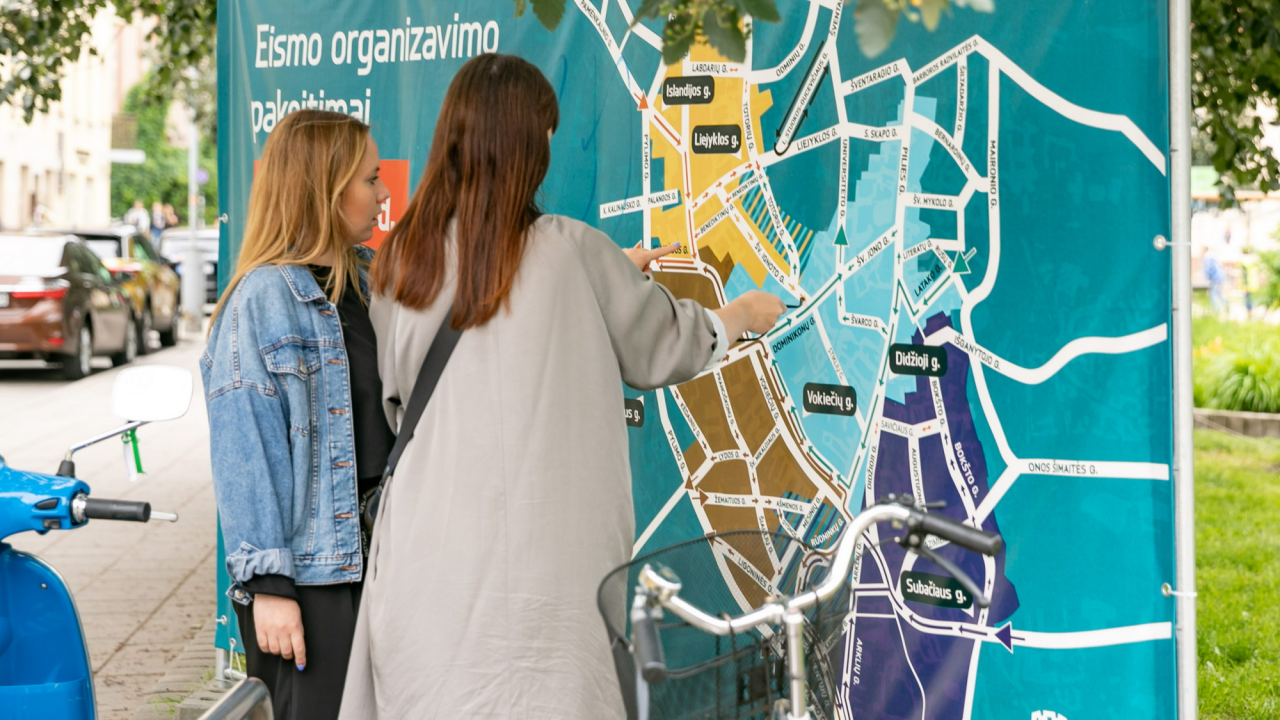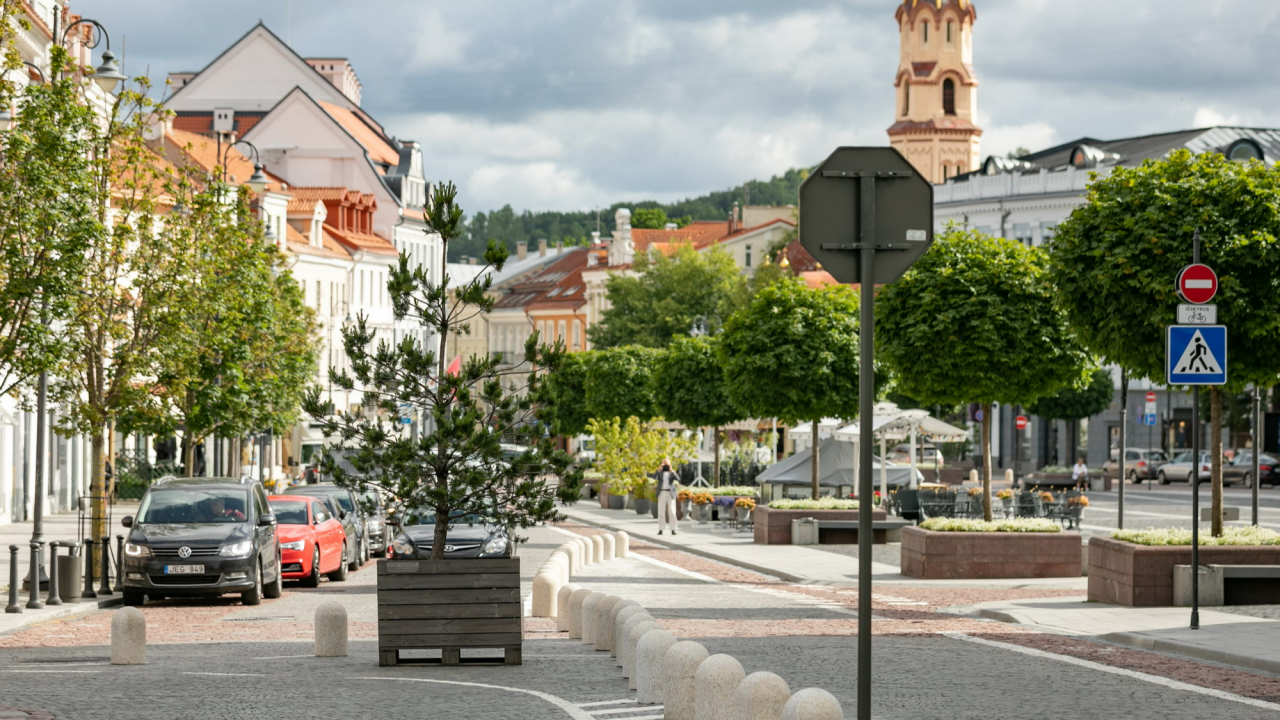Vilnius: A step towards low pollution zones

The Challenge
The core of the Old Town of the city of Vilnius and the archaeological area of the old town and its suburbs are extremely important in terms of cultural heritage values (in 1994 the Vilnius Old Town was included as a UNESCO World Heritage Site). Therefore, all actions had to consider the valuable properties, to comply with relevant legislation (e.g., the Law on the Protection of Immovable Cultural Heritage of the Republic of Lithuania, and the Heritage Management Regulation 2.13.01), and when applicable - carry out heritage conservation expertise in its technical projects.
The „loop traffic“ need was established in the Sustainable Mobility Plan of Vilnius (approved in December 2018). The goal of the loop traffic regulation was to reduce transit traffic in the core of the Old Town of the city of Vilnius. Before the loop traffic regulation, regular transit traffic in the heart of Vilnius accounted for 40%, while in the mornings - up to 70%. Long-lasted car traffic in the Old Town of the city markedly increased pollution and noise indicators, reduced the safety of road users. All of this therefore had negative impact on the quality of people’s life and leisure and the condition of historical buildings – cultural heritage.
The city therefore decided to introduce loop traffic and thus eliminate the possibility of using the streets of the Old Town to shorten transit car routes.
The Solution
The Loop traffic regulation was implemented by introducing one-way traffic, installing regulatory (prohibitory) road signs and physical barriers. In total, four main loops have been established. The loops are named after the names of the streets – the main entrances to the loops: Islandijos, Subačiaus, Latako and Trakų. The loops are used to organize the traffic of cars entering and leaving the old town. Each zone has one main entrance and one or two exits. Traffic in each loop is one-way only.
All vehicles, except for PT vehicles, are only allowed to move around in the loops.
The most optimal places were chosen for the installation of intelligent traffic systems. Electricity supply in the shortest and most efficient way was ensured.Solutions that would have the least visual impact on the old town were chosen.
Passenger pick-up/drop-off points have been installed in convenient locations. Bus stops were provided for hotel guests, although usually not right next to the door. Special areas were also set up for cargo logistics. Physical barriers - small architecture elements - flower beds, temporary trees and bushes – were placed.
Loop traffic is the first step towards low pollution zone introduction in Vilnius.

Making an impact
Introduction of loop traffic has improved the quality of life of residents and visitors of the Old Town – they are enjoying less car traffic, less noise and cleaner air. Some of the indicators which have helped the old town to become a more settled part of the city:
- Transit during morning peak reduced by 10%, and during evening peak – 8%.
- Attraction to the core of the old town on weekends increased by 12%.
- The noise level from traffic flow has decreased by 20%.
- Traffic safety indicators increased, i.e., the number of traffic accidents decreased by 40%.
- No pedestrians have been injured by cars to date.
- Residents and visitors of the Old Town can drive to their homes, workplaces, and attractions, but cannot cross the Old Town.
- Traffic is regulated by traffic signs, intelligent traffic system, barriers, small architecture objects, and a 20 km/h speed limit.
The Old Town area is also accessible via smaller streets, which belong to one of the four loops.
- Information about each zone is available at the entrance of each site and on-line.
- GPS navigation app has been created.
- Intelligent traffic system provides a lot of information (traffic intensity by hours, days, and loops; loop traffic violations; speed and route of movement of vehicles; vehicle time spent in loops; type of vehicle (EV, taxi), etc.
- Catering establishments are satisfied with the increased flow of visitors.
- Couriers enjoy using bicycles, scooters (with some limitation), and cargo bikes.

Lessons learnt
- A declined car traffic intensity during the quarantine allowed implementing the solution in 2020, instead of 2021 (as was originally planned).
- After the introduction of loop traffic in July 2020, in September of the same year, instantaneous and local field studies were conducted to determine trends in the structure of the distribution of traffic participants in the old town core. The results were compared with the modal distribution of trips.
- In the core of the old town, the traffic flow decreased, unfortunately, some of the traffic moved to the adjacent streets.
- Driving against traffic on a one-way street has been detected quite often.
- It would have been easier, if we would have implemented the intelligent traffic system right away instead of building physical barriers first.
- Coordination with all stakeholders was very difficult.
- We organized many presentations - to representatives of heritage, communities, Lithuanian Association of Hotels and Restaurants, embassies, and individual businesses. And although majority (except heritage institutions) opposed the innovation, the city continued the work anyway.
- The solution implementers valued and shared the good practices of several EU countries.
- The specialists of the traffic organization department physically drove through all the loops to make sure that fire department and other services had suitable traffic conditions.




















